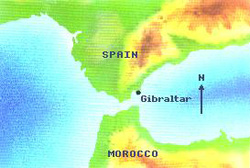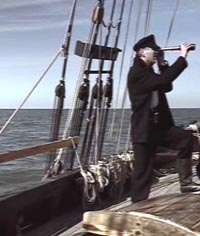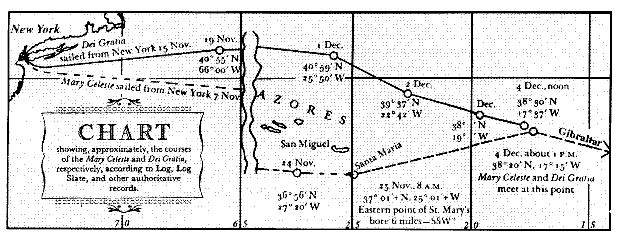The Story
It was 9am on the morning of Friday, December 13th 1872 when people on the waterfront saw a small two-masted sailing vessel entering the Bay of Gibraltar.
 The ship was the 'Mary Celeste' of New York, a Canadian built 100 foot brigantine of 282 tons registered in New York. The registered owners were James H Winchester (12/24) Sylvester Goodwin (2/24) and Benjamin Spooner Briggs (8/24).
The ship was the 'Mary Celeste' of New York, a Canadian built 100 foot brigantine of 282 tons registered in New York. The registered owners were James H Winchester (12/24) Sylvester Goodwin (2/24) and Benjamin Spooner Briggs (8/24).Her master, Benjamin Spooner Briggs known in Gibraltar to be a staunch abstainer and devout bible reader. At the inquiry the ships main owner James Henry Winchester gave evidence that the Captain was a courageous officer who would not dessert his ship except to save his life. The second-in-command, the Mate, was Albert Richardson, who was also considered by Winchester to be fit to command himself.
But of the good Captain Briggs, his wife Sarah, two year old daughter Sophia Matilda, and the crew of seven, nothing was to be seen or found ever again. And so begins the greatest of mysteries, or at least it might seem.
However, were it not for Dr Arthur Conan Doyle, struggling to establish himself as a writer prior to creating Sherlock Holmes, perhaps the world would not have ever known or cared.
The story, like many a tale, it has grown with the telling, to incorporate speculation of further mysteries, including pirates, creatures from the deep, abduction by aliens, submarines, and time travel.
Conan Doyle's short story about the 'Marie Celeste' (he changed the name from Mary) turned a minor puzzle into one of the most famous legends of the sea. Nevertheless we should recognise it was fiction, for which his editor paid 30 Pounds, which would have been a respectable sum in 1884.
Turning back to the REAL story, which survives because shipping companies and court inquiries leave behind ample records to be researched, we find the following facts;
 | The 'Mary Celeste' had sailed from New York on November 7th bound for Genoa with a cargo of 1701 barrels of American Alcohol, shipped by Meissner Ackermann & Co., value approximatly $35,000 the purpose of which was to fortify wine. The value of the freight on the alcohol was $3,400 and the ship herself $14,000. The Vessels cargo was insured in Europe, and the hull insurance was carried by American companies. The Freight was insured by the Atlantic Mutual Insurance Company of New York, today the only survivor of the American insurers. She was followed on 15th November by the 'Dei Gratia' which followed a roughly parallel course across the Atlantic carrying a cargo 1735 barrels of petroleum. On the Afternoon of December 5th 1872 half way between the Azores and the Portuguese coast the 'Dei Gratia' came up with a Brigantine which Captain Morehouse recognised as the 'Mary Celeste'. He knew Captain Briggs and had dined with him before he sailed. He was puzzled to see the ship yawing, coming into the wind and then falling off, she was out of control. He knew Captain Briggs to be a good seaman. There were no distress signals, and after watching for two hours and hailing her and getting no reply they set off in a small boat and duly boarded her. |
The vessel was found to be in good seaworthy condition and the general impression was that the crew had left in a great hurry. They had left behind their oil skin boots and pipes. Captain Morehouse's explanation was that they had left in panic thinking the vessel to be sinking. The chronometer and sextant were not found on board. The last entry on the ships slate showed she had made the island of St Mary in the Azores on November 25th.

Source : www.maryceleste.net
The Mystery of the Mary Celeste
by: Anna Derks
| One of the great maritime mysteries is that of the Mary Celeste.Over 125 years ago, the ship was found floating, crewless, in the middle of the Atlantic Ocean, in apparent pristine condition. The fate of the crew and passengers has never been adequately explained. The Mary Celeste was launched in 1861, from the shipyard at Spencer's Island near the head of the Bay of Fundy, under the name Amazon. Following an accidental grounding at Cow Bay in Cape Breton in 1868, she was repaired and renamed the Mary Celeste. She operated under an American flag out of New York. On November 7, 1872, the Mary Celeste sailed under the command of Captain Benjamin Briggs bound for Europe with a cargo of wines and liquors. He was accompanied by his wife, his young daughter and a crew of seven.  On December 4, 1872, the Mary Celeste was found floating 600 miles off Gibraltar. The official reports stated that everything to be in good order, except that the ship's paper and its chronometer were missing. The last entry into the captain's logs, on November 24, gave no indication of anything untoward happening or about to happen. On December 4, 1872, the Mary Celeste was found floating 600 miles off Gibraltar. The official reports stated that everything to be in good order, except that the ship's paper and its chronometer were missing. The last entry into the captain's logs, on November 24, gave no indication of anything untoward happening or about to happen.This is where the story gets a little murky and the mystery deepens. The condition of the Mary Celeste, at the time of her discovery at sea, vary according to the reporter. One report suggested that there were bloodied weapons on board and blood on some of the sail. If this is true it suggests a pirate attack, something that was common in that area around that period. But if it was a pirating, why was the money box and the ship's cargo of wine and liquor not taken? Pirates were known to take things from ships to better their personal finance. Another area of conflicting observation is whether or not the only lifeboat was still strapped to the ship. Some other theories put forward over the years concerning the Mary Celeste have included:
UPDATE #1 The final resting place of the Mary Celeste has been found by one of Bruce's heros, Clive Cussler. The ship kicked around for many years after its "ghostly" episode. It was scuttled on the Rochelois Reef in Haiti in about 1884. UPDATE #2 A recent communication with the webmaster of the Arthur Conan Doyle site at: http://www.siracd.com reminded us that there has always been a confusion over the spelling of the Mary Celeste. Some say that she was called the Marie Celeste. In 1883, Doyle's first literary success was "J. Habakuk Jephson's Statement" In this book he told the story of a black passenger. The passenger and his fellow conspirators commandeered the ship, sailed it to Africa and murdered the passengers and crew. The remarkable thing about this story to Doyle was that anyone believed it. Apparently many persons thought that the detailed description of the action was too got be just made up. Even U.S. consul Horatio J. Sprague demanded that the publishers, Cornhill Magazine, investigate the origin of the article. conspirators commandeered the ship, sailed it to Africa and murdered the passengers and crew. The remarkable thing about this story to Doyle was that anyone believed it. Apparently many persons thought that the detailed description of the action was too got be just made up. Even U.S. consul Horatio J. Sprague demanded that the publishers, Cornhill Magazine, investigate the origin of the article.From www.sircad.com, "Conan Doyle was pleased that his short story was so well done that it could be mistaken as a true accounting of events. He was also delighted that hundreds of readers, who did understand the work was fictional, thought it was written by a man known for his tales of adventure. They suspected that the anonymous author was none other than Robert Louis Stevenson." |
Source : www.mysteriesofcanada.com

0 comments: